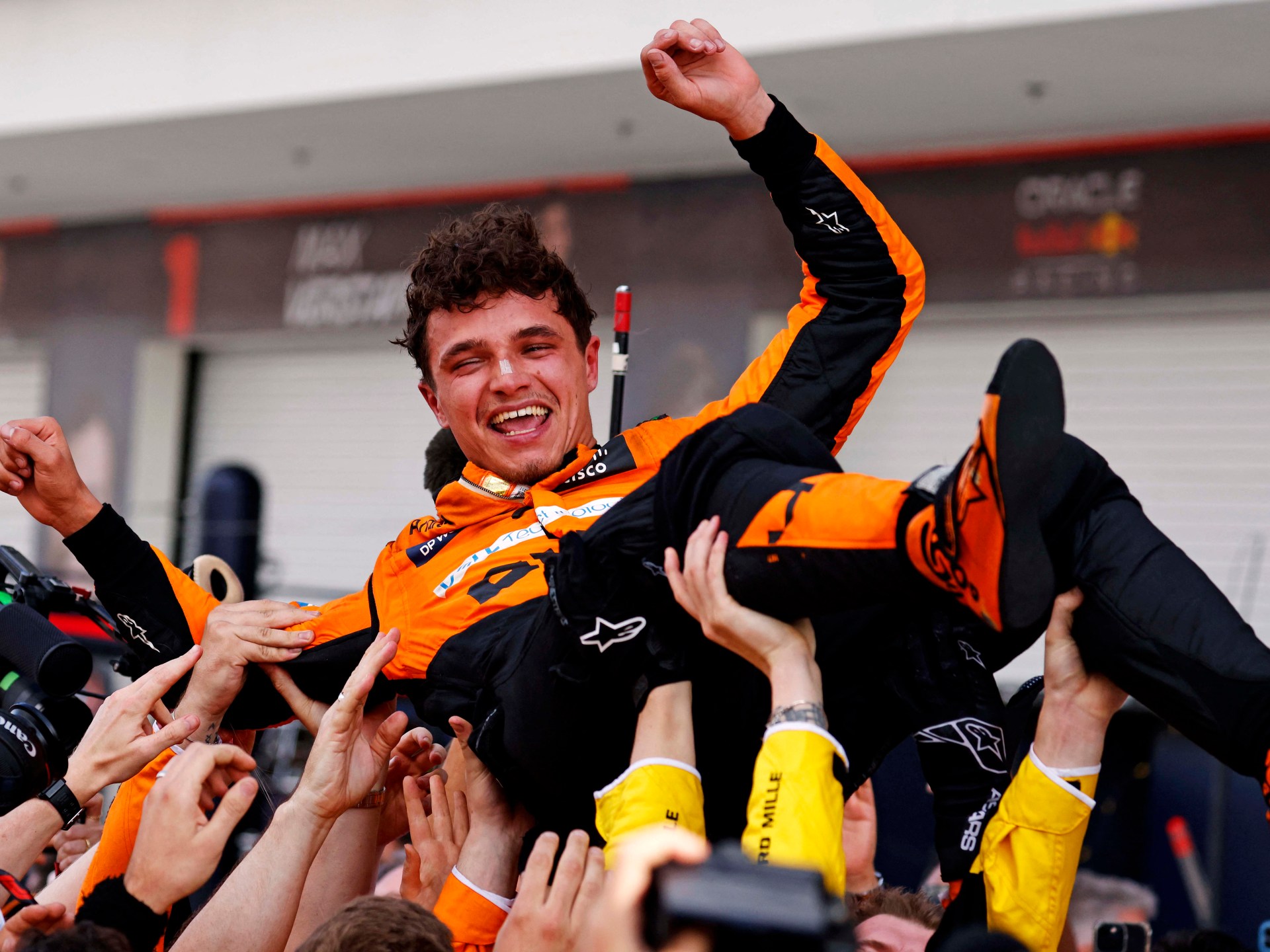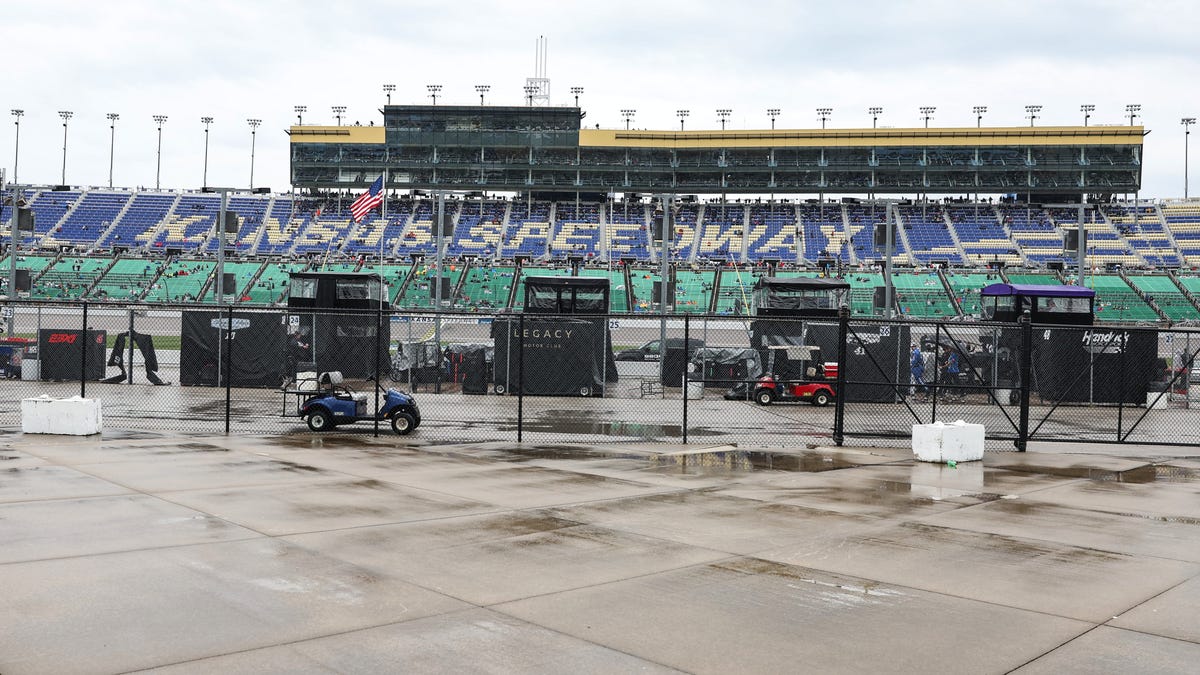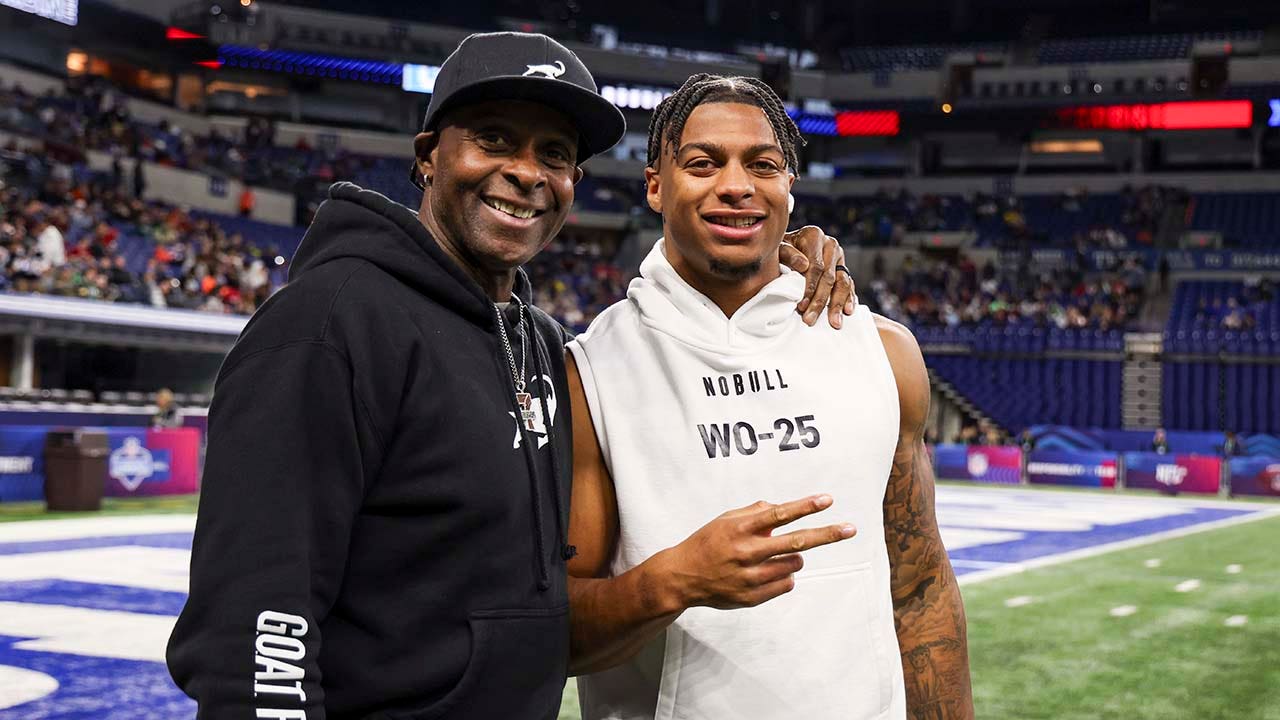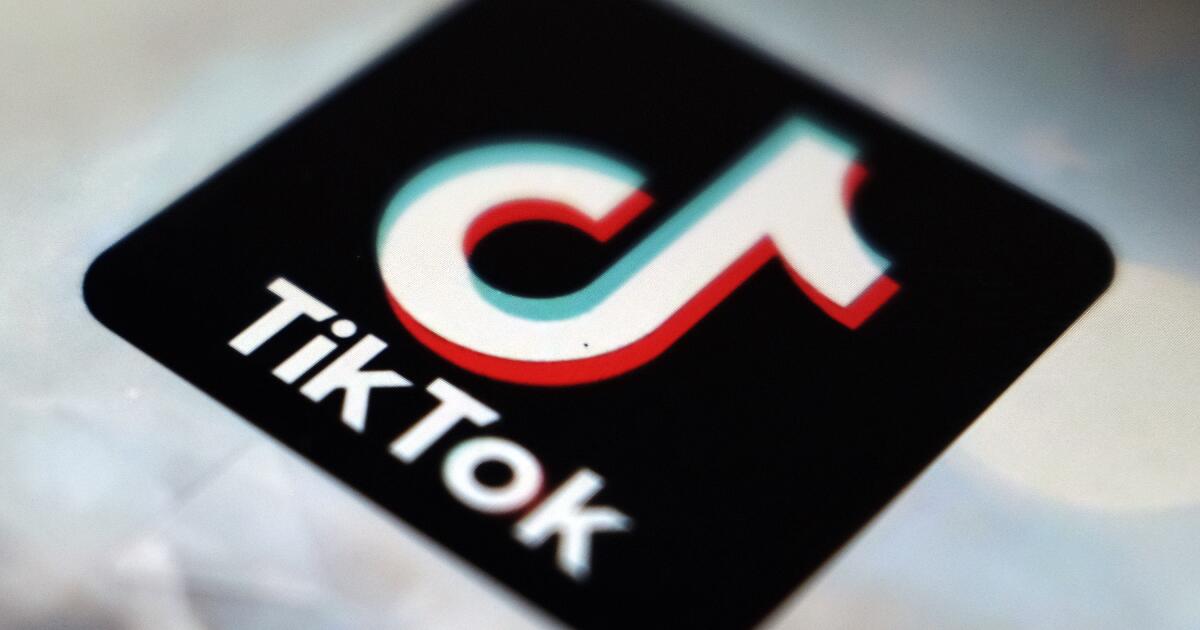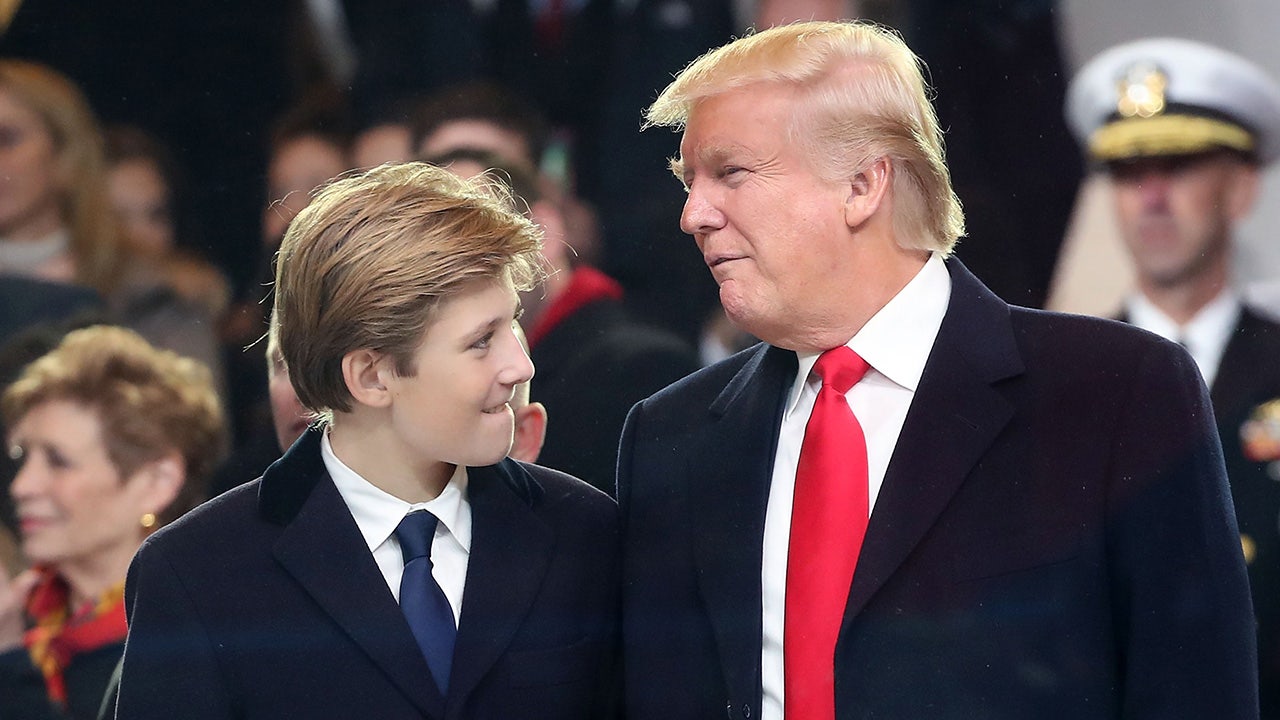Culture
The Daytona 500 is NASCAR's Super Bowl, so why doesn't it always equal greatness?

Readers can now follow NASCAR, Formula One and other motorsports content separately. Customize your feed here.
DAYTONA BEACH, Fla. — NASCAR Hall of Famer Jeff Gordon won the Daytona 500 twice in his first seven seasons, later adding another victory six years later, in 2005. Surely, he figured, there would be more to come.
Then Gordon never won NASCAR’s biggest race again.
“You get into this frustration of, ‘Man, what am I doing differently?’” Gordon said.
The answer, oddly enough, was nothing.
Such is the nature of this crown jewel NASCAR race, which represents a unique contrast in the realm of top sporting events: It is NASCAR’s Super Bowl in so many ways, but also remains one of the least reliable indicators of greatness.
Some of NASCAR’s most legendary names, like Tony Stewart, Rusty Wallace and Mark Martin, never won this race. Meanwhile, five of the last seven Daytona 500 victors have gone winless in that season’s remaining 35 events.
“You would assume in the biggest race of the year, the best teams and drivers would always win,” said Joey Logano, the 2015 Daytona 500 winner. “But it’s not like that.”
Logano brought the fastest car to this year’s 500, qualifying on the pole position there for the first time in his career. But the style of racing at NASCAR’s so-called “superspeedways” like Daytona means there are no guarantees Logano will have a good performance in the race, when well over three-quarters of the field has a legitimate chance to win. (The race, originally scheduled for Sunday, has been postponed to Monday at 4 p.m. ET due to rain.)
The reason is rooted in safety concerns. If NASCAR Cup Series cars were allowed to travel around Daytona’s high-banked, 2.5-mile course without restrictions, they could top 200 mph and put both competitors and fans at increased risk.
By requiring each car to have a “tapered spacer” — a hole-filled aluminum block that reduces the airflow to the engines — NASCAR limits speeds to try and keep cars from getting airborne and flying into (or through) the fences that separate the fans from the racetrack.
But there’s a side effect. The reduced horsepower means cars typically travel in giant packs, and drivers must rely on help from other competitors to draft around the track. Otherwise, they risk falling helplessly behind, unable to catch up as the field races off into the distance.
That makes the odds rise dramatically on two fronts: One, unheralded underdogs can hang with the elite long enough to pull off a shocking win; and two, even a slight bobble or mistake by one driver in the pack can trigger a large, multi-car crash known as “The Big One.”
“You’re not going to be fully in control of your destiny, and I’ve just accepted that,” said defending NASCAR champion Ryan Blaney, who has never won the Daytona 500 despite being one of the best superspeedway racers. “I’m going to do my best to try and stick around this thing, and if I get wiped out in something that’s not my fault, it’s like, ‘What can you do?’”
When Christopher Bell won Thursday night’s Daytona 500 qualifying race, he acknowledged a belief this style of racing was “100 percent luck.”
In reality, that’s an exaggeration. While luck undoubtedly plays a factor at Daytona, it’s not everything.
“I used to think this race was more luck than skill, but as I’ve studied more, the same guys are always up front,” said Kyle Larson, who is known as one of the most talented American drivers of his generation. “Those guys are not luckier than everybody else; they’re really talented when it comes to this style and they’ve got a good sense of how things work and where to be at the right time.”
Austin Cindric won the Daytona 500 in 2022, his only Cup Series win in 79 races. “The drivers who win this are the ones who remain calm and make good decisions,” fellow driver Tyler Reddick says. (Chris Graythen / Getty Images)
Becoming a top superspeedway racer requires a different skill set than typical tracks, which are more about drivers getting their car to handle better (and thus go faster) than the competition.
At Daytona, the best drivers have both excellent racecraft — knowing when to risk a move and when to stay put — and an innate sense of avoiding danger. Combined with those things, they also need savvy strategy calls from their teams, quick pit stops from their crews and, of course, good fortune.
“The smart ones can navigate through (the danger) or know, ‘I need to get out of this’ — or they’re already ahead of it to begin with,” said Tyler Reddick, who has crashed in all five of his Daytona 500 starts but won his Thursday qualifying race. “The drivers who win this are the ones who remain calm and make good decisions with the race approaching the end.”
Though the late Dale Earnhardt Sr. was mythically said to be able to “see the air,” the reality of modern-day drivers is they must see the video. Along with their spotters, who narrate and even dictate which moves should be made from positions high above the track, drivers pore over film of previous races to understand which moves work, which ones backfire and which ones cause major crashes.
Some teams track analytics, like the best running positions in the pack that correlate to success. But even then, there are still so many elements out of their control.
Brad Keselowski, for example, has led the most laps in each of the last two Daytona 500s — part of 177 career laps led in this race — but has never won it. Now 40 and running out of time to claim a Daytona 500 crown, Keselowski said he’d trade leading those laps in exchange for leading the last one.
“You go to the Daytona 500, and you’ve done all this preparation work … and more often than not, the result feels unearned either way,” he said. “Like many things in life, you just have to recognize it’s not always fair and accept it and move on. But it’s difficult to reconcile, for sure.”
Keselowski, Kyle Busch and Martin Truex Jr. are among the current Cup Series champion drivers nearing the end of their careers without a Daytona 500 victory. Busch has said he badly wants to win the 500 more than any other remaining accomplishment, but also acknowledged “it’s just one race.”
Drivers throughout the NASCAR garage continue to wrestle with that dichotomy; as Gordon said, “somebody is going to win this race, and there’s no other win like it.”
On the other hand, as Logano noted, a Daytona 500 trophy — or lack thereof — doesn’t define a driver’s career.
“It’s an unbelievable stat to have on your resume,” Logano said. “That part is fantastic. But if you had to decide between winning 15 Cup races over one Daytona 500, you’d probably rather win 15 Cup races.”

GO DEEPER
Daytona 500 lineup: Ranking all 40 drivers on their chances to win
(Top illustration: John Bradford / The Athletic; photos: Jared C. Tilton, Jonathan Ferrey, Jared C. Tilton / Getty Images)

Culture
Ben Shelton: 'I didn't want to be one of 50 Nike guys'

“I wanted to be a little bit different from anyone else,” Ben Shelton said recently in Madrid.
He was actually talking about his decision last year to sign a major deal with the small-but-growing Swiss shoe and apparel manufacturer On, rather than pursuing a certain American behemoth with a famous swoosh. (More on that in a bit.) The Floridian was in the early days of a three-month sojourn in Europe that will last as long as he does at Wimbledon, which ends in mid-July.
But Shelton, who is 21, could have been talking about anything to do with his budding tennis career, which has been the opposite of cookie-cutter.
Football (the American kind), in addition to tennis, until middle school? Different.
Regular high school rather than a tennis academy? Different.
Zero junior Grand Slam appearances? Different.
Major doses of collegiate exuberance: the “Yeah!” after big and small shots, the since-retired, hang-up-the-phone exclamation point on his wins? Different.
And now that the clay swing is here, Shelton is once more cutting against the grain, moving on to Rome and the Italian Open as he treats a third-round loss in Spain last week as just another step in tackling something that has beguiled most American men for a good long while.
That would be that red clay.
GO DEEPER
Who is Ben Shelton? Meet the U.S. Open’s new American phenom
The easy brutality of Shelton’s tennis, which carried him to the semi-finals of the U.S. Open last year, can be deceiving.
He can blast his serve at 150mph (241kph) and rocket forehands like few others, cutting points short at a breath or stealing momentum in a rally.
At first glance, that gives him the sort of stereotypical, big American game that won’t easily translate to the dirt. Other notable Yanks with those qualities have basically held their noses and endured these months of attritional-style tennis, counting the days until the grass and hard courts of summer.
Well, that’s not how Shelton rolls.
He spent the two weeks leading up to his departure for Spain at a hardcore clay-court boot camp. “I worked on the things that I needed to: on the court, off the court, strength, fitness, moving,” he said. “I just really honed in.”
Rather than enduring the soft stuff, Shelton is embracing it. This is something other American men have traditionally avoided, including his own father and coach, Bryan, a touring pro in the 1980s and 1990s. He often swerved red clay other than the French Open, and the odd other tournament, for most of his career.
“I realized too late that my game was pretty well-suited to it,” he said after a practice session with his son last week. “I had this big kick-serve. I could push guys back. It opened up the court.” He shook his head, still annoyed with his younger self, 30 years on.
His kid isn’t letting such assumptions take root. He’s taking a different approach.
Late last year, Shelton asked Gabriel Echevarria, a veteran trainer, to join his team full-time as a strength and conditioning coach. It was another off-beat but logical move for someone who is as strong as a lumberjack and can run like a deer but remains prone to being wrong-footed or taken off-balance.

Shelton wants to move on the dirt like the best of them (Julian Finney/Getty Images)
Echevarria, who spent the past dozen years working for the U.S. Tennis Association and Tennis Australia, is Argentinian. He has a reputation for possessing a special knowledge of what it takes to attain proper movement and balance in tennis — especially on clay, the most common tennis surface in Argentina.
The ideal candidate to lead a crash course.
The most common mistake for clay-court newbies, Echevarria said, is sliding after the shot, which wastes time, rather than sliding into the shot. Certain shots require fewer steps, or smaller ones, or an extra step.
“If we learn the skill, then we can develop the skill, but the first thing is to learn the proper way,” Echevarria explains. “Once you learn the proper way, the model pattern, then we can develop that skill.”
Shelton perceives Echevarria as a kind of clay whisperer, who has helped him to understand its idiosyncrasies. “The clay court is just a little bit different than the hard court,” Shelton says. “You can’t do the same things.”
So, before each day of training, not in Monte Carlo or Barcelona where tournaments were happening but back home in Florida, Echevarria and Shelton’s father would talk about what movement to focus on. Sometimes, it was learning how to run diagonally, which happens often on clay because of all the drop shots and slices. Other times, it was how to recover and shift from one shot to the next.
Then, Shelton would head onto the court to try out what he had just learned for two or three hours. After a break and some lunch, afternoons consisted of more time on the court if Bryan felt it was necessary, and/or up to 90 minutes in the gym. It was gruelling, and exposed Shelton to the need to attune himself to what he found under his feet.
“Every clay court is just a little bit different,” he says.
- If you’d like to follow our fantastic tennis coverage, please click here.

Shelton’s serve allows him to dominate, even on the slower surface (Julian Finney/Getty Images)
“The bounces are unpredictable, so you can’t always rely on short-hopping a ball — taking a ball early. You can get too close to the bounce or set your feet too early and the bounce can be unpredictable and go in a direction that you don’t think it’s gonna go,” he explains.
This is particularly true in Madrid, where the altitude (2,000ft/650m above sea level) adds speed to the flight of the ball, creating the kind of conditions that left Daniil Medvedev gesturing at his coaching team with impotent rage, frustrated by being in the right place at the wrong time, or maybe the other way around. Rome, softer, slower, at sea level, carries its own quirks.
Shelton? He isn’t bothered. He’s thoughtful, and he’s here for it.
“You have a little bit more time to play because, in most places, the clay is a little bit slower than hard courts, but actually here in Madrid, it’s really fast,” he said.
“But for the most part, the game slows down a bit. So you have more time, which I really like. But at the same time, you gotta learn how to use that time and learn how to defend against guys who also have more time.”

GO DEEPER
Why you should be excited about this year’s tennis clay court swing
These are the words of someone determined not to repeat their father’s sins, someone who wants to be a little different than what a lot of the world might expect of a player with his unique brand of raw power and athleticism.
It was not so different from the choice he made a little more than a year ago to roll the dice a bit in that deal with On.
He had attended college at the University of Florida, a quintessential Nike school. So many of the biggest figures in American tennis and American sports have become synonymous with the swoosh over the years: John McEnroe, Andre Agassi, Michael Jordan Tiger Woods, LeBron James, and on and on.
“I didn’t want to be one of 50 Nike guys,” Shelton says. “Obviously it was also a big draw with On having probably the biggest icon in the history of tennis — you know, other than, like, Serena (Williams).” Shelton is referencing Roger Federer, who acquired a significant stake in On five years ago, with the company building and launching a debut tennis apparel collection on the back of his involvement, along with that of Shelton and the women’s world No 1 Iga Swiatek.
Here was Shelton, a dude, a male tennis star no less, kind of, sort of, putting Federer a slot behind Serena Williams in the sport’s pecking order, or at least putting them on the same plane. That doesn’t happen too often.

Shelton on his way to the title in Houston this year (Aaron M. Sprecher/Getty Images)
On an unseasonably chilly Saturday evening in Madrid two weeks ago, Shelton took the court for his opening match against Tomas Machac of the Czech Republic.
Machac, who is 23, has been tearing through some of the best players in the world this season. He plays a silky, deceptively powerful, all-court game and, like most central European players, largely grew up on clay.
He may be ranked 35 spots below Shelton, who is now world No. 14, but he is the sort of player who has proven to be a nightmare for Americans on clay practically forever.
Shelton promptly tore through Machac, 6-0, 6-2.
He used his power to push the Czech far behind the baseline, then moved forward himself, sending volleys and drop shots into the open court. He took advantage of that little extra time clay gives — “I love time on the ball,” he says — and jumped all over Machac’s second serve, taking it early, claiming the momentum.
Two days later, Shelton was a point away from a likely cruise to a straight-set win over Alexander Bublik of Kazakhstan. He struggled to handle a couple of Bublik’s notoriously relentless drop shots, scrambling uncomfortably, and that allowed Bublik the crack of light he needed to climb back into the match. The Kazakh would win in three sets, 3-6, 7-6(2), 6-4.
This was the live version of the clay tutorial Shelton is seeking from Echevarria. Regardless of the defeat, it was a 180-degree turnaround from when he landed in Europe a year ago for his first red-clay season. “Last year, I just had no idea what to expect,” he said.
That’s not his fault. There just isn’t a lot of red clay in America, where players largely learn the game on hard courts.

GO DEEPER
20 years of Grand Slam drought: Which American man has come closest to winning since 2003?
Growing up in Florida, Shelton played some on green clay, which is harder to move on and produces far less predictable bounces than the red variety. Sloane Stephens, another Floridian and the 2018 French Open runner-up, calls red clay “the real stuff”. Still, Shelton barely hit a ball on clay after he turned 16 and his focus shifted to college tennis, which is a hard-court affair.
His match today, Friday May 10, in Rome against Pavel Kotov will be just his 16th professional contest on clay, and that includes four wins in the U.S. Clay Court Championships in Houston early last month. He won that tournament and, while any ATP Tour title is nothing to sneeze at, Shelton knew he remained well short of being ready to contend at Roland Garros. So, the boot camp. The learning. The discomfort, the embrace of something not quite what he expected. Being, in a word, different.
Some good tennis players become great by becoming a higher quality version of the player they were when they first broke into the tour. Others go from good to great by opening their mind to new skills.
What’s Shelton?
“He’s like a sponge,” Echevarria says.

Shelton’s slingshot serve is a trademark of his game (On)
Shelton emerged from that boot camp believing he could thrive on clay, maybe not today or tomorrow, but eventually.
Clay forces him to become the kind of player he wants to be — a threat on every surface not simply because his serve is a game-altering cruise missile, but because he can move the ball around the court with spin and height over the net, and come into the net and volley into an open court and grind when the moment requires it.
“Americans haven’t had the best success in the clay-court season or at Roland Garros, but it’d be really cool to change that narrative,” he says.
He also doesn’t think he has a choice. Clay season lasts two months. It’s not the four-week sprint grass season is. There are simply too many rankings points up for grabs on clay courts for someone with designs on reaching the top of the game to concede anything.
Americans aren’t generally known for their patience. They like stuff now — immediate gratification. Focusing on process over results doesn’t always come naturally. But once more, Shelton is a little different in that area, with some nudging from Echevarria and his father.
He is approaching this clay swing as he did the boot camp, as an opportunity to learn, to collect information, to analyze how he has improved, to see if he can execute all those step patterns and all that sliding on the most famous crushed red brick in the world.
If winning happens, great. If not? Fine. Just like clay calls for, Team Shelton is playing a long game.
“We don’t get frustrated,” Echevarria says. “We don’t worry about it because we know that, guess what? The French Open is going to be played on clay next year. It’s going to be played on clay for 100 years.”
(Top photos: L-R: On; Centre: ATP Tour; design: Dan Goldfarb)
Culture
Lazerus: Facing elimination, Hurricanes have organizational soul-searching to do

RALEIGH, N.C. — This column won’t be fair. Not really. Not when a bounce here, a whistle there, a lucky break somewhere, anywhere, could have changed the entire complexion and narrative of this series, of this team, of the very perception of this organization. Not when this team has looked so strong at five-on-five, not when the ephemeral nature of special teams is the root cause of its current ills, not when every game it plays — and every damn game it loses — seems to be decided by one goal, one shot, one deflection. Not when this team has enjoyed the longest sustained run of success in the history of the franchise.
But we need to talk about the Carolina Hurricanes.
Not in the same sentence as the Toronto Maple Leafs — that’s too harsh, too melodramatic. But in the same paragraph.
Because it’s not working. It hasn’t worked. And it appears it won’t work.
You know by now what the Hurricanes are all about. Depth over elite finishers. Quantity of shots over quality. Relentlessness over resourcefulness. Goaltending that’s always good enough, never great enough. It works so beautifully, so majestically, from October through April. But it hasn’t worked in May, and they haven’t even made it to June.
Carolina is an organizational marvel, one of the best-run and most forward-thinking front offices in the league. The Hurricanes have built a monster, a team that’s so deep, so fast, so effective, so ferocious on the forecheck. They win battles. They retrieve pucks. They wear down opponents. They won the NHL’s rough-and-tumble Metropolitan Division three years in a row before getting barely edged out by the Presidents’ Trophy-winning New York Rangers this season by 3 points. They’ve finished among the top three teams in the league in each of the past four seasons. The analytical models adore them, the bettors favor them, and the hockey men and computer kids alike respect them.
Then the playoffs come around, and, well, this happens.
The Hurricanes are on the brink again, trailing their second-round series against the Rangers 3-0 after Artemi Panarin’s acrobatic tip-in 1:43 into overtime Thursday night gave New York a 3-2 victory. It was a gut-wrenching way for Carolina to lose, especially after Andrei Svechnikov scored the equalizer with 1:36 left in regulation, sending the cacophonous PNC Arena into absolute bedlam. It felt like that could be a turning point in the series. Instead, it just became another turn of the knife.
HAVE A GAME, ANDREI! pic.twitter.com/6jfaD9Af6H
— Carolina Hurricanes (@Canes) May 10, 2024
It was just as cruel in Game 2 on Tuesday night, when the Hurricanes lost in double overtime at Madison Square Garden. And when they lost 4-3 in Game 1. And when they lost all four games of last season’s Eastern Conference final against the Florida Panthers, each by one goal, two of them in overtime, one of them in quadruple overtime, the sixth-longest game in NHL history. Their last eight postseason losses have come by one goal, five in overtime.
Always chasing one more goal. Always trying to get over the hump. Never quite getting there.
“It’s a little bit of a broken record,” Canes captain Jordan Staal said quietly Thursday night. He was talking about another game in which special teams — such a strength all season — betrayed Carolina. The league’s second-best power play went 0-for-5 for the third straight game. The Hurricanes even allowed a short-handed goal to Chris Kreider and two more prime short-handed chances on top of that.
But Staal could have been talking about the bigger picture, too. Because we’ve seen this May frustration too many times now.
If you count the Play-In round of the 2020 bubble playoffs, Carolina has won a postseason round in six straight seasons. It’s the kind of sustained run of competitiveness that most of the league would do anything to attain. But Carolina hasn’t won a single game beyond the second round in those six seasons, swept in the Eastern Conference final in 2019 and 2023. The Hurricanes Way works extremely well in the regular season. It makes quick work of wild-card-level playoff teams, such as the New York Islanders the past two seasons.
But against other elite teams — the ones with all-world players such as Panarin, or Matthew Tkachuk and Aleksander Barkov, or Nikita Kucherov and Brayden Point, and all-world goalies such as Igor Shesterkin or Sergei Bobrovsky or Andrei Vasilevskiy — they come up just short. Agonizingly short. So short that it feels like a toss-up every time, that it feels unfair to hold those losses against them, that it feels like the hockey gods are just toying with them in their own cruel way.
But still short. Always short.
And so Hurricanes coach Rod Brind’Amour can say ad nauseam that he has loved Carolina’s five-on-five game against the Rangers. He should. The Hurricanes were the better team at evens in all three games. And we can point to Pyotr Kochetkov’s brilliant pokecheck of a Kreider breakaway in the final minute of regulation or any number of Frederik Andersen saves in the first two games. And we should. Both goaltenders were solid. And we can point out that Carolina acquired the finisher it’s always lacked in Jake Guentzel and that he has scored three goals in the past two games. And we should. He’s been as advertised.
But eventually, trip-ups become a trend, stumbles become a signature. And though the extremity of each situation varies wildly, the Hurricanes find themselves in a similar situation to the Maple Leafs, who have turned “run it back” into a punchline, running into a brick wall spring after spring after spring. The Canes are better than the Leafs. The Canes have accomplished more than the Leafs. The Canes are built as the polar opposite of the star-laden, top-heavy Leafs. But the Canes have won the Stanley Cup as many times as the Leafs. That’s what it’s about, right? Both have been constructed to win championships. Neither has come all that close.
Toronto fired coach Sheldon Keefe on Thursday. Carolina obviously won’t be doing the same with Brind’Amour, one of the best coaches in the league. He’s due a new contract, but it’s unfathomable for the franchise icon to be behind the bench anywhere else. He’ll be back. But Carolina can rethink things. The top duo of Sebastian Aho and Svechnikov are locked up long-term, but the roster is rife with pending free agents. General manager Don Waddell will have the kind of cap flexibility most contenders can only dream of. Waddell can pursue more high-end talent up front and maybe in goal. Brind’Amour can tinker with his system, maybe loosening the structure and the strictures of Carolina’s dump-and-chase, funnel-pucks-to-the-net-from-anywhere-and-everywhere style and encouraging more creativity, more offensive boldness. Something. Anything. Because the Rangers attack the net. The Hurricanes just shoot at it.
Barring a historic comeback from a 3-0 deficit that renders this column and this narrative more moot than the foolish notion that hockey can’t thrive in a southern market, Waddell and Brind’Amour have to decide whether they, too, want to run it back. Or if it’s time for something different.
“It’s a new day tomorrow,” Staal said. “It’s gonna hurt tonight — won’t get much sleep. But we’ll have a new day tomorrow, and we’ll find a way to win one game. It’s been our model here for a long, long time.”
And it’s worked for a long, long time. Just not quite well enough. Just not when it matters the most.
(Photo of Martin Necas: Bruce Bennett / Getty Images)
Culture
Catcher's interference calls are skyrocketing in MLB. It's putting players at risk

Weeks before Opening Day this season, Major League Baseball sent a memo to all 30 clubs highlighting a rise in catcher’s interference. The instances of catchers being struck by the bats of opposing hitters were rising rapidly. Catcher’s interference was called 94 times in 2023, nearly 20 more times than in 2022.
What was causing the dramatic uptick? Catchers kept moving closer to the plate. In the era of pitch framing, teams deduced that the closer a catcher is to receiving a pitch, the better chance he has to “steal” a strike.
It worked well enough that catchers kept shifting closer to the batter’s box. The memo this spring essentially warned teams to cut it out and move catchers farther behind the plate to minimize risk.
But anyone who saw St. Louis Cardinals catcher Willson Contreras sustain a fractured left arm Tuesday night knows that risk remains ever-present.
Catcher’s interference calls continue to skyrocket at a historic pace. The average catcher’s interference total from 2010 to 2018 was 31. This year, it’s been called 33 times — less than two months in.
MLB’s concerns were already growing. There are more than double the interferences in 2024 compared to the 2022 season at the same point (15). The league is on pace for a record 148 catchers interferences this season. The push to frame the lower strike has inadvertently put the safety of catchers in jeopardy.
“The risk is high,” Cardinals manager Oli Marmol said earlier in the week. “We just experienced it.”
Contreras was struck flush by the swing of New York Mets’ designated hitter J.D. Martinez. The catcher underwent surgery on Wednesday and will miss a minimum of six to eight weeks. Contreras was one of baseball’s worst framers last year on borderline pitches below the zone. The Cardinals, a defense-oriented club, worked extensively with Contreras to improve in that regard.
Over his first year in St. Louis, the Cardinals overhauled Contreras’ approach, including his set-up behind the plate (Contreras ditched the traditional crouch behind the plate in favor of the one-knee down method). They also did indeed move Contreras closer to the plate.
The Cardinals are hardly the only team in baseball to deploy this method, but they were the first to pay the price for it this season.
“The more catchers are evaluated on framing, the closer they’re getting to the hitter in order to get to that low pitch,” Marmol said. “You’re seeing more catchers do that based on being able to get the low pitch, but you’re also seeing more catcher’s interference and backswings getting guys based on them being closer. Sometimes the catcher unknowingly could get closer and closer from hitter to hitter without noticing.”
That seems to have been the case for Contreras, who was caught by the swing of Martinez, who has a naturally deep swing and sets up as close to the back of the batter’s box as possible. Replays showed the head of Martinez’s bat hitting Contreras’ left arm square. It also showed just how far Contreras had reached in his attempt to frame the pitch.
Willson Contreras will leave this game after taking a J.D. Martinez swing to his left arm. pic.twitter.com/mJfiqOBf4t
— Bally Sports Midwest (@BallySportsMW) May 8, 2024
“There’s always a risk being a catcher,” Contreras said after the injury. “Could have been something different. It could’ve been off my knee, it could be a concussion. That risk is always going to be there. I’m not blaming any part of my game because this happened tonight.”
Perhaps that’s the problem. No position player in baseball takes a more constant beating than the catcher. And as teams across the board covet the low-strike call, catchers take the brunt of the consequences.
“We used to always talk about catcher interference being long strings on your glove or ticking your glove,” Detroit Tigers manager A.J. Hinch, who caught seven seasons in the big leagues said. “Then it turned into the glove in its entirety. (Contreras) is one of the first I’ve seen on a limb.”
“That is risky,” Hinch added. “The closer we get to the plate the more strikes we can grab at the bottom rail. Catchers are getting evaluated. They’re getting paid on how well they can control the bottom rail. That’s led to more and more catcher interferences throughout the game. … We do want our guys close enough to be impactful with the low strike but not walking into harm’s way. It’s a tough balance when the incentive to do it is real and the risk is extreme.”
Some teams stress the low strike more than others. Philadelphia Phillies manager Rob Thomson was a catcher in the Tigers organization for four seasons. He was taught that as the bat comes through the zone, the glove should follow.
“You’re going to catch more foul tips,” Thomson said. “You’re closer to the plate, you’re closer to the strike zone. It’s a better presentation for the umpire.”
Still, Thomson prefers his catchers keep some distance from the plate.
‘”We keep our eye on guys that do that and remind the catcher, ‘You got to back up a little bit,’” he said.
The happy medium for some teams seems to be self-monitoring. The Minnesota Twins, for example, monitor their catcher every pitch. It’s one of the primary in-game responsibilities of first-base and catching coach Hank Conger.
“A good, tight setup generally speaking is better than worse, something you prefer. But it’s obviously to avoid not just catcher interference, but injuries, too,” manager Rocco Baldelli said. “I think there’s a few reasons why (being closer) is helpful, but there are other times that we’re yelling at them to back the hell up to also be helpful, you know?”
The Atlanta Braves have two coaches assigned to catching duties. Sal Fasano is the catching coach. He’s assisted by Eddie Pérez, who spent nine of his 11 big-league seasons catching for the Braves. Pérez certainly understands the strategy behind being close to the plate but thinks the responsibility to inform the catcher he’s too close falls on those watching the game from the dugout.
“It’s always a good idea to be closer to the hitter,” Pérez said. “It’s thought that if you’re closer to the hitter, you’re going to get more calls.”
“Sal always reminds them to go back, you don’t want to get hurt,” Pérez added. “From (the dugout) you see better. When you’re catching you don’t know how far you are from the hitter, and every hitter has a different setup, so you have to adjust. … As a catcher, they’ve got to tell you from the side how close you are to the hitter.”
But the accidental blows behind the plate can sometimes be a two-way street. Catchers are frequently clipped by hitters’ swings regardless of where they’re positioned. With the average bat speed registering roughly 75 mph, some argue the responsibility lies on the batter to ensure not just their physical body remains within the parameters of the batter’s box, but their swing as well.
“The thing I don’t necessarily agree with is it can be the way people are swinging, too,” Chicago Cubs manager Craig Counsell said. “It can be the way catchers are setting up, yes. But it also can be kind of the way some people are swinging. And it’s dangerous.”
With the league on notice and MLB clearly aware of the risks, what can be done to cut down catcher’s interference — and the inherent injury risk? Cardinals’ starting pitcher Miles Mikolas suggested a physical line behind the plate that catchers cannot cross, a box of their own in a way. Could the automated ball-strike system (which theoretically eliminates the value of framing) be the answer? Possibly, but it’s an imperfect system in the minor leagues and is far from being a big-league product.
“I don’t know what they could possibly do other than reward the hitter with more bases, put him on second base,” Hinch said. “There are things you could probably do to make it super impactful to the game, but I don’t know if anything can be more impactful than losing one of your best players for six to eight weeks, 10 weeks, whatever it’s gonna be.”
The Cardinals now know how severe that impact can be. The bigger question looms: Does baseball?
— The Athletic‘s Matt Gelb, Cody Stavenhagen, Aaron Gleeman, Patrick Mooney, David O’Brien and Eno Sarris contributed to this story.
(Photo of Contreras being helped off the field: Jeff Roberson / Associated Press)
-

 News1 week ago
News1 week agoPolice enter UCLA anti-war encampment; Arizona repeals Civil War-era abortion ban
-

 News1 week ago
News1 week agoSome Florida boaters seen on video dumping trash into ocean have been identified, officials say
-

 Politics1 week ago
Politics1 week agoThe White House has a new curator. Donna Hayashi Smith is the first Asian American to hold the post
-

 Education1 week ago
Education1 week agoVideo: President Biden Addresses Campus Protests
-
)
) Movie Reviews1 week ago
Movie Reviews1 week agoThe Idea of You Movie Review: Anne Hathaway’s honest performance makes the film stand out in a not so formulaic rom-com
-

 World1 week ago
World1 week agoUN, EU, US urge Georgia to halt ‘foreign agents’ bill as protests grow
-

 World1 week ago
World1 week agoIn the upcoming European elections, peace and security matter the most
-

 World1 week ago
World1 week agoArizona Senate repeals near-total 1864 abortion ban in divisive vote


